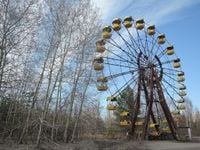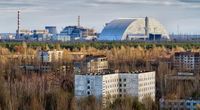On April 24, 2025, the world remembers the Chernobyl disaster, a catastrophic event that occurred 39 years ago, on April 26, 1986. The blast from reactor number four at the Chernobyl nuclear power plant not only marked a tragic chapter in human history but also left a lasting impact on the perception of nuclear energy across Europe. The disaster, which was classified as a level 7 event on the International Nuclear Event Scale (INES), was the result of a combination of design flaws and human errors during a safety test that went horribly wrong.
At 1:23 AM on April 26, 1986, the first explosion, resembling thunder, echoed through the night, followed by a second, quieter explosion that sent shockwaves across the nearby town of Pripyat, located just three kilometers from the plant. Many residents, unaware of the impending catastrophe, were oblivious to the danger, with some even mistaking the initial blast for fireworks. Firefighters, unprepared and lacking protective gear, rushed to the scene, unaware that they were combating a nuclear fire. Tragically, many of them succumbed to acute radiation sickness within weeks, their heroic efforts ultimately costing them their lives.
In the days following the explosion, radiation levels in Pripyat skyrocketed, exceeding safe limits by hundreds of thousands of times. Yet, life continued as normal for the residents until the evacuation order was issued on April 27, 1986, a full 36 hours after the explosion. They were told to take only essential items, leaving behind their homes and lives. The radioactive cloud released during the disaster spread rapidly, reaching Poland and Scandinavia by the following day, while Moscow remained silent until pressured by international scrutiny.
Mikhail Gorbachev, who became the First Secretary of the Communist Party just a year prior, addressed the disaster publicly two weeks later, acknowledging its severity. The Chernobyl disaster forced the Soviet leadership to confront the systemic incompetence and lack of transparency that had characterized their governance. The aftermath saw the contamination of an area spanning 125,000 to 146,000 square kilometers, displacing over 350,000 people and leading to an estimated death toll ranging from 4,000 to as high as 200,000, depending on various assessments.
As the years passed, Chernobyl became a symbol of both disaster and resilience. Before the onset of the war in Ukraine in 2022, it had transformed into a popular tourist destination, attracting around 120,000 visitors annually. The allure of dark tourism captivated many, drawn by the haunting remnants of a once-thriving city, now a ghost town overtaken by nature. Tourists explored the abandoned buildings, schools, and amusement parks, often without a deep understanding of the tragedy that unfolded there.
Dr. Philip Stone, an American scholar specializing in dark tourism, suggests that the fascination with Chernobyl stems from humanity's inherent attraction to fear and the desire to confront it. The HBO series "Chernobyl" reignited interest in the disaster, winning numerous awards and prompting discussions about nuclear safety and the implications of such technology.
However, the shadow of Chernobyl looms large, especially in the context of recent geopolitical events. In February 2025, a Russian drone struck the sarcophagus protecting the Chernobyl site, sending shockwaves through Europe as concerns over nuclear safety resurfaced. Fortunately, the International Atomic Energy Agency confirmed that no radioactive materials were released during the incident. Yet, the attack was viewed as a political maneuver, heightening fears of nuclear threats amid ongoing tensions.
In Poland, the memories of Chernobyl have influenced public opinion on nuclear energy. Following the Russian invasion of Ukraine, support for nuclear power surged dramatically. A survey conducted in November 2024 revealed that 92.5% of Poles favored the construction of nuclear power plants, with many expressing willingness to have one built near their homes. This marked a significant increase from just 39% support in May 2021, reflecting a growing recognition of the need for energy independence from Russian gas.
The Polish Nuclear Energy Program aims to establish two nuclear power plants within the next 20 years, with the first, located in Lubiatowo-Kopalino, expected to reach full capacity in approximately 13 years. Experts emphasize that modern nuclear technologies are vastly safer than those used during the Chernobyl era, addressing public concerns and fears.
Yet, the legacy of Chernobyl remains a stark reminder of the potential dangers associated with nuclear energy. The psychological impact of the disaster continues to affect those who lived through it, particularly older generations who still recall the panic and uncertainty following the explosion. The haunting memories of the iodine pills distributed to children as a precaution against radiation exposure linger in the collective consciousness.
As the anniversary of the disaster approaches, it serves as a sobering reminder of the lessons learned and the importance of vigilance in nuclear safety. While the world has made strides in improving safety protocols and technology, the specter of Chernobyl remains a powerful symbol of the potential consequences of human error and systemic failure.
In the end, Chernobyl is not just a historical event; it is a living lesson that continues to shape discussions about energy policy, safety, and the responsibility that comes with harnessing the power of the atom. As Europe grapples with its energy future, the echoes of Chernobyl remind us to tread carefully as we navigate the complexities of nuclear energy.



